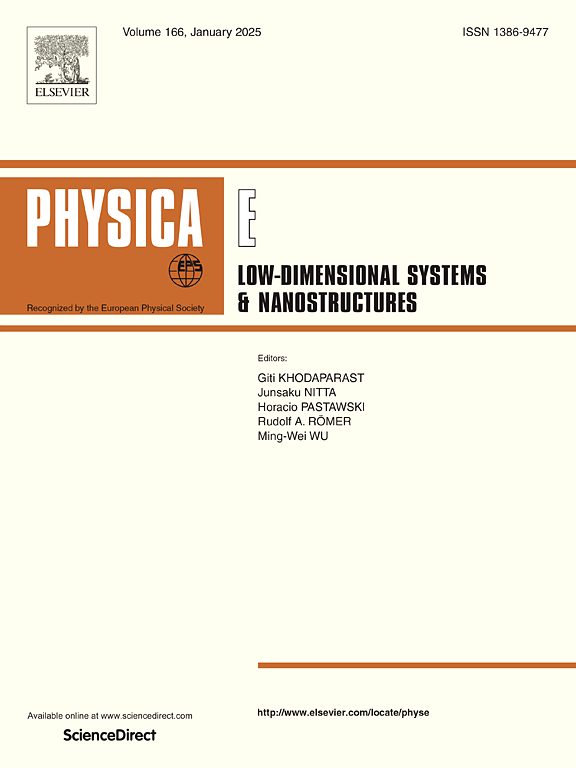Predicting BN analogue of 8-16-4 graphyne: In silico insights into its structural, electronic, optical, and thermal transport properties
IF 2.9
3区 物理与天体物理
Q3 NANOSCIENCE & NANOTECHNOLOGY
Physica E-low-dimensional Systems & Nanostructures
Pub Date : 2025-02-01
DOI:10.1016/j.physe.2024.116163
引用次数: 0
Abstract
The boron nitride (BN) analogue of 8-16-4 graphyne, termed SBNyne, is proposed for the first time. Its physical properties were explored using first-principles calculations and classical molecular dynamics (MD) simulations. Phonon dispersion calculations and ab initio molecular dynamics simulations revealed that this system is dynamically stable at room temperature. We found that SBNyne exhibits a wide indirect bandgap of 4.58 eV using HSE06 and 3.20 eV using PBE. It displays strong optical absorption in the ultraviolet region while remaining transparent in the infrared and visible regions. Additionally, SBNyne exhibits significantly lower thermal conductivity compared to h-BN. Phonon spectrum analysis indicates that out-of-plane phonons predominantly contribute to the vibrational density of states only at very low frequencies, explaining its low thermal conductivity. These findings expand the knowledge of two-dimensional (2D) BN materials and open new avenues for their design and advanced technological applications.

求助全文
约1分钟内获得全文
求助全文
来源期刊
CiteScore
7.30
自引率
6.10%
发文量
356
审稿时长
65 days
期刊介绍:
Physica E: Low-dimensional systems and nanostructures contains papers and invited review articles on the fundamental and applied aspects of physics in low-dimensional electron systems, in semiconductor heterostructures, oxide interfaces, quantum wells and superlattices, quantum wires and dots, novel quantum states of matter such as topological insulators, and Weyl semimetals.
Both theoretical and experimental contributions are invited. Topics suitable for publication in this journal include spin related phenomena, optical and transport properties, many-body effects, integer and fractional quantum Hall effects, quantum spin Hall effect, single electron effects and devices, Majorana fermions, and other novel phenomena.
Keywords:
• topological insulators/superconductors, majorana fermions, Wyel semimetals;
• quantum and neuromorphic computing/quantum information physics and devices based on low dimensional systems;
• layered superconductivity, low dimensional systems with superconducting proximity effect;
• 2D materials such as transition metal dichalcogenides;
• oxide heterostructures including ZnO, SrTiO3 etc;
• carbon nanostructures (graphene, carbon nanotubes, diamond NV center, etc.)
• quantum wells and superlattices;
• quantum Hall effect, quantum spin Hall effect, quantum anomalous Hall effect;
• optical- and phonons-related phenomena;
• magnetic-semiconductor structures;
• charge/spin-, magnon-, skyrmion-, Cooper pair- and majorana fermion- transport and tunneling;
• ultra-fast nonlinear optical phenomena;
• novel devices and applications (such as high performance sensor, solar cell, etc);
• novel growth and fabrication techniques for nanostructures

 求助内容:
求助内容: 应助结果提醒方式:
应助结果提醒方式:


